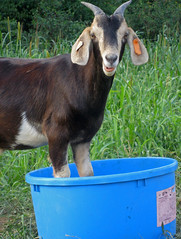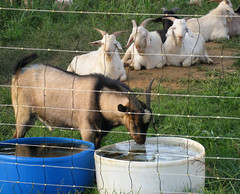Urinary calculi or “water belly” is a common metabolic disease of male sheep and goats. The disease occurs when calculi (stones), usually comprised of phosphate salts, lodge in the urinary tract and prevent urination. Normally, phosphorus is recycled through saliva and excreted via feces in ruminants. High grain, low roughage diets decrease the formation of saliva and therefore increase the amount of phosphorus excreted in the urine.
The primary cause of urinary calculi is feeding concentrate diets which are excessive in phosphorus and magnesium and/or have an imbalance of calcium and phosphorus. Lack of water and water sources that are high in minerals are also contributing factors.
Who's at Risk?
 While urinary calculi can occur in intact males, wethers are at greatest
risk because castration of young males removes the hormonal influence (testosterone)
necessary for the penis and urethra to reach full size.
While urinary calculi can occur in intact males, wethers are at greatest
risk because castration of young males removes the hormonal influence (testosterone)
necessary for the penis and urethra to reach full size. Lambs castrated within the first month of life are most vulnerable. For this reason, some veterinarians advocate delaying castration until after puberty. If castration is performed after puberty, it should be done under anesthesia by a veterinarian.
It is generally recommended that lambs and kids be castrated between 1 and 7 days of age, especially if rubber bands are used. The better recommendation might be for producers to carefully consider whether it is necessary or desirable to castrate ram lambs and buck kids. Intact males grow faster and produce leaner carcasses, and there is no difference between the meat from a young intact male and a castrated lamb or kid.
In females, calculi are formed, but excreted due to anatomic differences in the male and female urinary tract.
What are the Symptoms?
Clinical signs vary. They usually start with restlessness and anxiety. Affected animals may experience abdominal pain, urine dribbling, distention and rupture of the urethra. They will usually experience a loss of appetite. They may have a humped-up appearance and edema under their belly. They may kick at their belly and strain to urinate. Dribbled urine may be bloody.
As pain and discomfort increases, affected animals will isolate themselves. In goats, there may be increased vocalization and tail twitching. If left untreated, affected animals will die when the bladder bursts and urine fills the peritoneal cavity and is absorbed into the bloodstream. Sometimes, it may be necessary to humanely destroy an affected animal to avoid further suffering.
How to You Treat It?
Treatment of urinary calculi depends upon the location of the obstruction and could be as simple as snipping off the urethral process to allow calculi at the end of the penis to dislodge. Tranquilizers and antispasmodics may help to naturally dislodge some calculi. In more advanced cases, surgical intervention may be necessary to save valuable animals or pets. Veterinary advice should be sought in this case.
How Do You Prevent It?
 Like most disease conditions,
it is better to prevent urinary calculi than to treat it. It can be prevented
by feeding rations which contain a calcium-to-phosphorus ratio of at least
2:1. The ratio of Ca:P should never be allowed to go below 1:1. High calcium
diets are effective at reducing the absorption of phosphorus from the GI
tract.
Like most disease conditions,
it is better to prevent urinary calculi than to treat it. It can be prevented
by feeding rations which contain a calcium-to-phosphorus ratio of at least
2:1. The ratio of Ca:P should never be allowed to go below 1:1. High calcium
diets are effective at reducing the absorption of phosphorus from the GI
tract. Neither magnesium or phosphorus should be added to concentrate diets. Diets should also contain adequate amounts of vitamin A. Supplements should not be haphazardly added to otherwise balanced rations. Horse feed should not be fed to small ruminants because horse diets are not balanced for ruminants and can lead to stone formation
Extra calcium is well tolerated by sheep, so where rations are unbalanced, they can be counterbalanced by adding ground limestone (not dicalcium phosphate!). Legume hays (alfalfa, clover, lespedeza, etc.) are good sources of calcium. In addition, roughage will increase salivation and rumination which will increase the amount of phosphate excreted in the urine.
Cereal grains (corn, barley, etc.), on the other hand, have an abnormally low calcium-to-phosphorus ratio: 1:4 to 1:6. Therefore, rations containing cereal grains need to be balanced with other feeds or mineral sources to form a complete ration that has the proper ratio of calcium and phosphorus.
When formulating your own feed rations, you need to include minerals in the ration or a source of calcium (such as legume hay). Free choice minerals may not be adequate to prevent urinary calculi in male goats and sheep, since you do not know if they are consuming sufficient quantities of the mineral. Minerals should be force-fed. When feeding textured feeds or mixed rations (e.g. whole grain + pellets), you need to make sure the animals are not picking at certain feed ingredients. This can also lead to an imbalance of Ca and P being consumed.
Adequate water intake is also necessary to prevent urinary calculi. Inadequate water intake causes the urine to be more concentrated, which makes the formation of stones more likely. Water should be proper temperature and clean. Force feeding salt (up to 4% of the ration) will help to increase water intake. However, salt should not be added to the water source, since lambs and kids will find it unpalatable and drink less water.
The use of ammonium chloride at a level of 0.5 percent of the total diet will help to acidify the urine and prevent the formation of calculi. Most commercial lamb and meat goat diets contain ammonium chloride, as well as the proper ratio of Ca:P.
No comments:
Post a Comment